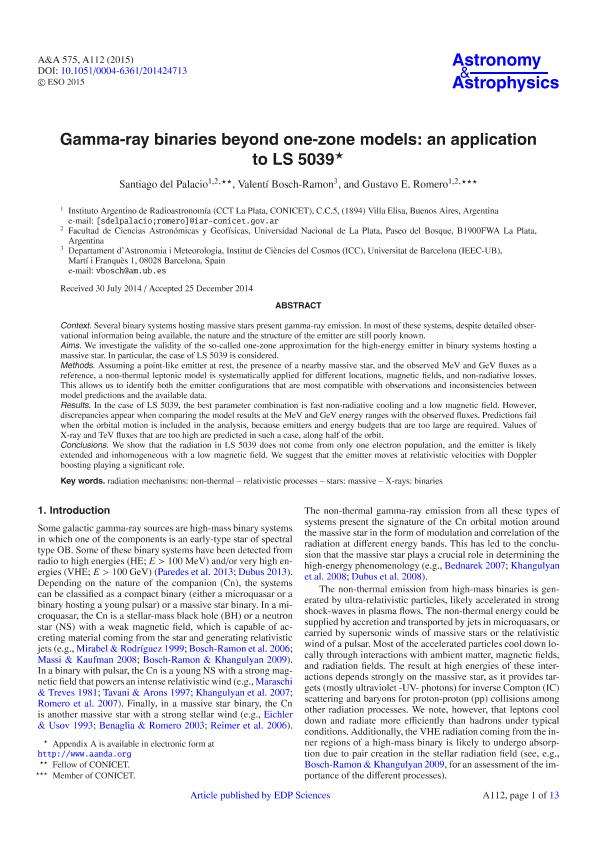Mostrar el registro sencillo del ítem
dc.contributor.author
del Palacio, Santiago

dc.contributor.author
Bosch-Ramon, Valentí
dc.contributor.author
Romero, Gustavo Esteban

dc.date.available
2016-08-11T13:49:25Z
dc.date.issued
2015-03
dc.identifier.citation
del Palacio, Santiago; Bosch-Ramon, Valentí; Romero, Gustavo Esteban; Gamma-ray binaries beyond one-zone models: an application to LS 5039; Edp Sciences; Astronomy And Astrophysics; 575; A112; 3-2015; 13
dc.identifier.issn
0004-6361
dc.identifier.uri
http://hdl.handle.net/11336/7086
dc.description.abstract
Context. Several binary systems hosting massive stars present gamma-ray emission. In most of these systems, despite detailed observational information being available, the nature and the structure of the emitter are still poorly known.
Aims. We investigate the validity of the so-called one-zone approximation for the high-energy emitter in binary systems hosting a massive star. In particular, the case of LS 5039 is considered.
Methods. Assuming a point-like emitter at rest, the presence of a nearby massive star, and the observed MeV and GeV fluxes as a reference, a non-thermal leptonic model is systematically applied for different locations, magnetic fields, and non-radiative losses.
This allows us to identify both the emitter configurations that are most compatible with observations and inconsistencies between model predictions and the available data.
Results. In the case of LS 5039, the best parameter combination is fast non-radiative cooling and a low magnetic field. However, discrepancies appear when comparing the model results at the MeV and GeV energy ranges with the observed ?uxes. Predictions fail when the orbital motion is included in the analysis, because emitters and energy budgets that are too large are required. Values of X-ray and TeV fluxes that are too high are predicted in such a case, along half of the orbit.
Conclusions. We show that the radiation in LS 5039 does not come from only one electron population, and the emitter is likely extended and inhomogeneous with a low magnetic field. We suggest that the emitter moves at relativistic velocities with Doppler boosting playing a significant role.
dc.format
application/pdf
dc.language.iso
eng
dc.publisher
Edp Sciences

dc.rights
info:eu-repo/semantics/openAccess
dc.rights.uri
https://creativecommons.org/licenses/by-nc-sa/2.5/ar/
dc.subject
Massive Stars
dc.subject
Binary Systems
dc.subject
Gamma Rays
dc.subject
Ls 5039
dc.subject
Gamma-Ray Emission
dc.subject
X-Ray Binaries
dc.subject
Relativistic Processes
dc.subject
Nonthermal Mechanisms
dc.subject
Radiation Mechanisms
dc.subject.classification
Astronomía

dc.subject.classification
Ciencias Físicas

dc.subject.classification
CIENCIAS NATURALES Y EXACTAS

dc.title
Gamma-ray binaries beyond one-zone models: an application to LS 5039
dc.type
info:eu-repo/semantics/article
dc.type
info:ar-repo/semantics/artículo
dc.type
info:eu-repo/semantics/publishedVersion
dc.date.updated
2016-07-26T15:12:38Z
dc.journal.volume
575
dc.journal.number
A112
dc.journal.pagination
13
dc.journal.pais
Francia

dc.journal.ciudad
Paris
dc.description.fil
Fil: del Palacio, Santiago. Consejo Nacional de Investigaciones Científicas y Técnicas. Centro Cientifico Tecnológico la Plata; Argentina
dc.description.fil
Fil: Bosch-Ramon, Valentí. Universitat de Barcelona (IEEC-UB). Departament d’Astronomia i Meteorologia, Institut de Ciències del Cosmos (ICC) ; España
dc.description.fil
Fil: Romero, Gustavo Esteban. Consejo Nacional de Investigaciones Científicas y Técnicas. Centro Cientifico Tecnológico la Plata; Argentina
dc.journal.title
Astronomy And Astrophysics

dc.relation.alternativeid
info:eu-repo/semantics/altIdentifier/doi/http://dx.doi.org/10.1051/0004-6361/201424713
dc.relation.alternativeid
info:eu-repo/semantics/altIdentifier/url/http://www.aanda.org/articles/aa/abs/2015/03/aa24713-14/aa24713-14.html
Archivos asociados
